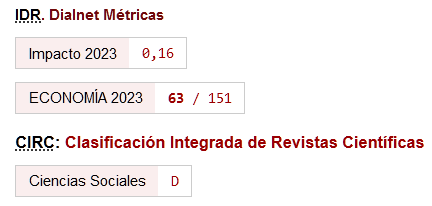Environmental balance of the High Speed Rail line in the Northern Spain: a Life Cycle Analysis approach
DOI:
https://doi.org/10.46661/rec.10156Keywords:
High Speed Train, Sustainable mobility, Life Cycle Analysis (LCA), Environmental impact, Energy consumptionAbstract
Spain has the world’s second longest network of High-Speed Rail (HSR) lines built and in service. HSR is usually presented as a sustainable means of transport with huge potential to reduce greenhouse gas (GHG) emissions and energy consumption. The majority of studies carried out on this mode of transport have focused on analysing and estimating these savings in terms of network operation, but sometimes ignore the burdens associated with the construction of the infrastructure.
This article analyzes the environmental loads of construction and operation of the Northern Corridor and verifies if its construction is justified in terms of reducing environmental impacts and reducing energy consumption. To do so, it integrates into the study the construction and maintenance phase of the line, together with the operation phase. More specifically, the study is based on the life cycle analysis (LCA) methodology, which includes the calculation of the loads associated with the construction of the infrastructure and distributes them throughout its useful life.
This study concludes that this high-speed North line will not compensate, during its useful life, the environmental impacts generated in its construction and maintenance phase, nor will it contribute to net energy savings
Downloads
References
ADIF. (2020). Adif—Líneas de alta velocidad. ADIF Alta Velocidad. http://www.adifaltavelocidad.es/es_ES/
infraestructuras/lineas_de_alta_velocidad/lineas_de_alta_velocidad.shtml
Adra, N., Michaux, J.-L., & André, M. (2010). Analysis of the load factor and the empty running rate for road transport. Artemis—Assessment and reliability of transport emission models and inventory systems. [ResearchGate]
Akerman, J. (2011). The role of high-speed rail in mitigating climate change – The Swedish case Europabanan from a life cycle perspective. Transportation Research Part D: Transport and Environment, 16(3), 208-217. [https://doi.org/10.1016/j.trd.2010.12.004]
Banar, M., & Özdemir, A. (2015). An evaluation of railway passenger transport in Turkey using life cycle assessment and life cycle cost methods. Transportation Research Part D: Transport and Environment, 41, 88-105. [https://doi.org/10.1016/j.trd.2015.09.017]
Barnes, E. (2014). California High Speed Resilience to Climate Change. En Center for Earth Systems Engineering and Management. [http://hdl.handle.net/2286/R.I.25239]
Baron, T., Martinetti, G., & Pépion, D. (2011). Carbon footprint of high speed rail. International Union of Railways (UIC). [http://trid.trb.org/view.aspx?id=1134978]
Betancor, O., & Llobet, G. (2015). Contabilidad financiera y social de la alta velocidad en España. FEDEA: Área de infraestructuras y Transportes.
Bueno, G., Hoyos, D., & Capellán-Pérez, I. (2017). Evaluating the environmental performance of the high speed rail project in the Basque Country, Spain. Research in Transportation Economics, 62, 44-56. [https://doi.org/10.1016/j.retrec.2017.02.004]
California High-Speed Rail Authority. (2016). California High-Speed Rail Sustainability Report. 54.
Chang, B., & Kendall, A. (2011). Life cycle greenhouse gas assessment of infrastructure construction for California’s high-speed rail system. Transportation Research Part D: Transport and Environment, 16(6), 429-434. [https://doi.org/10.1016/j.trd.2011.04.004]
Chester, M., & Horvath, A. (2010). Life-cycle assessment of high-speed rail: The case of California. Environmental Research Letters, 5(1), 014003. [https://doi.org/10.1088/1748-9326/5/1/014003]
Cornet, Y., Dudley, G., & Banister, D. (2017). High Speed Rail: Implications for carbon emissions and biodiversity. Case Studies on Transport Policy. [https://doi.org/10.1016/j.cstp.2017.08.007]
Cour des Comptes. (2014). La grande vitesse ferroviaire: Un modele porte au-dela de sa pertinence. [https://www.ccomptes.fr/sites/default/files/EzPublish/20141023_rapport_grande_vitesse_ferroviaire.pdf]
Cuenot, F. (2016). Carbon Footprint of Railway Infraestructure: Comparing existing methodologies on typical corridors. UIC-ETF, 51.
De Rus, G. (2011). The BCA of HSR: Should the Government Invest in High Speed Rail Infrastructure? Journal of Benefit-Cost Analysis, 2(1), 1-28. [https://doi.org/10.2202/2152-2812.1058]
Dorsey, B., Olsson, M., & Rew, L. J. (2015). Ecological Effects of Railways on Wildlife. En R. van der Ree, D. J. Smith, & C. Grilo (Eds.), Handbook of Road Ecology (pp. 219-227). John Wiley & Sons, Ltd. [http://onlinelibrary.wiley.com/doi/10.1002/9781118568170.ch26/summary]
Enterate. (2018). Mapa de trenes AVE España 2018 (líneas, rutas, destinos...). ENTERAT.COM. [http://www.enterat.com/servicios/mapa-ave-espana.php]
European Commission. (2011). A Roadmap for moving to a competitive low carbon economy in 2050 (COM (2011) 112 final). Communication from the Commission to the European Parliament, the Council, the European Economic and Social Committee and the Committee of the Regions. https://www.eca.europa.eu/Lists/ECADocuments/SR18_19/SR_HIGH_SPEED_RAIL_EN.pdf
European Commission. (2013). EU energy, transport and GHG emissions—Trends to 2050: Reference scenario 2013. Luxembourg: European Commission.
European Court of Auditors. (2018). A European high-speed rail network: Not a reality but an ineffective patchwork. https://www.eca.europa.eu/Lists/ECADocuments/SR18_19/SR_HIGH_SPEED_RAIL_EN.pdf
European Environment Agency. (2018). Transport: Increasing oil consumption and greenhouse gas emissions hamper EU progress towards environment and climate objectives. https://www.eea.europa.eu/themes/transport/intro
Galán, J., Alameda, D., & Abad, J. M. (2017, marzo 3). AVE: Estas son las estaciones de alta velocidad más y menos utilizadas de España | Economía | EL PAÍS. https://elpais.com/economia/2017/03/01/actualidad/1488362770_011434.html
García Álvarez, A. (2010). Energy Consumption and Emissions of High-Speed Trains. Transportation Research Record: Journal of the Transportation Research Board, 2159, 27-35. https://doi.org/10.3141/2159-04
García, P. (2017, noviembre 12). Las ocho estaciones del AVE en España con menos de 150 pasajeros al día. El Independiente. https://www.elindependiente.com/economia/2017/11/12/estaciones-ave-espana-menos-viajeros/
Heather Jones, Filipe Moura, & Tiago Domingos. (2016, agosto 3). Life cycle assessment of high-speed rail: A case study in Portugal. ResearchGate. https://www.researchgate.net/publication/305820361_Life_cycle_assessment_of_high-speed_rail_a_case_study_in_Portugal
Jehanno, A., Palmer, D., & James, C. (2011). High Speed Rail and Sustainability. International Union of Railways, UIC. http://old.uic.org/download.php/publication/531E.pdf
Ministerio de Transportes, Movilidad y Agenda Urbana. (2018). Anuario estadístico 2018. Capítulo 8. Tráfico. https://www.mitma.gob.es/recursos_mfom/paginabasica/recursos/08trafico_18.pdf
Observatorio del Ferrocarril en España. Informe 2015. (2016, diciembre). https://www.fomento.gob.es/NR/rdonlyres/2D6FF366-18BE-4D71-9C0B-DFA456575AFB/142179/Informe_OFE2015.pdf
SPRI. (2020, enero 22). Tapia: “La Y vasca es el salto cualitativo más importante en la transición ecológica de nuestro país”. https://www.spri.eus/es/infraestructuras-comunicacion/tapia-la-y-vasca-es-elsalto-cualitativo-mas-importante-en-la-transicion-ecologica-de-nuestro-pais/
Tuchschmid, M., Knörr, W., Schacht, A., Mottschall, M., & Schmied, M. (2011). Carbon Footprint and environmental impact of Railway Infrastructure. International Union of Railways, UIC. https://uic.org/IMG/pdf/uic_rail_infrastructure_111104.pdf
Yue, Y., Wang, T., Liang, S., Yang, J., Hou, P., Qu, S., Zhou, J., Jia, X., Wang, H., & Xu, M. (2015). Life cycle assessment of High Speed Rail in China. Transportation Research Part D: Transport and Environment, 41, 367-376. https://doi.org/10.1016/j.trd.2015.10.005
Zembri, P., & Libourel, E. (2017). Towards oversized high-speed rail systems? Some lessons from France and Spain. Transportation Research Procedia, 25, 368-385. https://doi.org/10.1016/j.trpro.2017.05.414
Downloads
Published
How to Cite
Issue
Section
License
Copyright (c) 2021 Andoni Kortazar, Gorka Bueno, Andoni Cortazar

This work is licensed under a Creative Commons Attribution 4.0 International License.
This licence allows third parties to share (copy and redistribute the material in any medium or format) and adapt (remix, transform and create from the material for any purpose, including commercial purposes), provided that authorship and first publication in this journal (The Journal, DOI of the work) is acknowledged, a link to the licence is provided, and it is stated whether changes have been made to the work.







